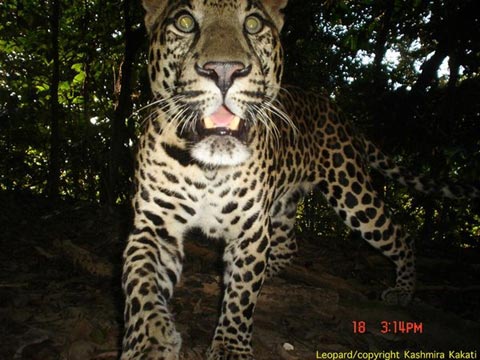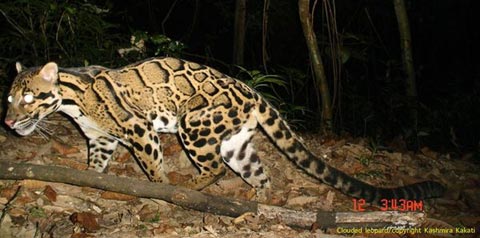Seven species of strange cats were discovered in the rainforest
The researchers found seven strange species of cats in a 570-square-kilometer area of the tropical rainforest Jeypore-Dehing in northeastern India's Assam state .
Thus, this area has the highest diversity in the world of cats.
Wildlife researcher Kashmira Kakati studied gibbon species at Jeypore-Dehing. The curiosity about predators here urges her to search and track them.
Kakati said: 'I need to learn something out there. Nobody has any clue. People are present in the forest for 30 years without knowing anything '.

A newspaper prowled under the thick canopy of "sticky" traps photographed.
From 2007 to 2009, with the installation of 30 photography traps, Kakati captured many rare animals belonging to the cat family. She was amazed at the results.
(*) Tropical rainforest is a sub-system of rainforest distributed in the hot and humid tropical areas with a normal rainfall of 1,750mm - 2,000mm in 1 year. An interesting feature of the tropical rainforest is the thickness of the leaves that delay the natural rain falling to the ground.
Cloud coat

A rare Asian forest cat.
In photos from camera traps, there is a rare photograph of an Asian wildcat (Latin name Neofelis nebulosa ). Their names are set according to the characteristics of the colorful patterned fur.
According to the International Union for Conservation of Nature (IUCN), Asian wild cats are classified as in danger of being threatened, meaning that the species is facing a high risk of extinction.
This number of cats is decreasing, mainly due to habitat loss due to deforestation. Kakati said that, at Jeypore-Dehing, they were rarely seen, not even named by local people.
Baby newspaper

This wildcat has a very leopard-like fur.
In another image is a small forest cat with spotted hairs (Latin name is Felis bengalensis ). According to IUCN, this species is popular in Asia.
Golden moment

A cat with golden fur and bright eyes in the night.
Tropical rainforest Jeypore-Dehing is also home to the Asian yellow cat listed in the IUCN's near-extinct list.
In addition to the seven species of cats found, Kakati's camera traps also recorded 12 other predator species within Jeypore-Dehing, including South Asian jackals, Malay sun bear and some mammals. other like civet.
Forest cat

This wild cat may have fled here from another forest.
Kakati said Jeypore-Dehing is surrounded by oil, coal, timber and hunting activities, a threat to wildlife. Some animals, including wild cats in the picture above, migrated to Jeypore-Dehing from the neighboring forests.
The back of the lord lord

The camera trap also captures a picture of a female tiger living in the forest.
Camera traps recorded images of about 45 mammal species, including monkeys, deer, porcupines, wild boars and rodents. They are prey for the predators of the forest, including the female tiger in the picture above.
Although many cats are at risk from poaching to get their bones and skin, according to Kakati, people in Jeypore-Dehing do not hunt these species but hunt deer and wild pigs.
Protect spotted animals

The precious cat (Latin name, Pardofelis marmorata ), is in danger of extinction.
Researchers hope the discovery of many rare Jeypore-Dehing cats, including the extinct close-up cat in the picture, will encourage the Indian government to protect a larger area in the region. eastern Himalaya.
- The 'strange' cats in the world
- Colombia discovered three species of frogs never known
- Discover new monkey species in the Amazon rainforest
- Brazil discovered 12 new animals in the Amazon rainforest
- New creatures at the Borneo rainforest
- Strange ability of cats
- Strange creatures glow themselves to catch prey
- Who was the first to tame a cat?
- Discover more than 1,000 new species of creatures
- Why cats lick you? The answer is simple but not everyone knows!
- Interesting discovery of the only cat that can live in the desert
- Why do dogs hate cats?
 Animal 'suffering' after hibernation
Animal 'suffering' after hibernation Why do goats climb well?
Why do goats climb well? Scientists were surprised to see chimpanzees eating turtles
Scientists were surprised to see chimpanzees eating turtles Giant catfish died deadly due to drought in Thailand
Giant catfish died deadly due to drought in Thailand